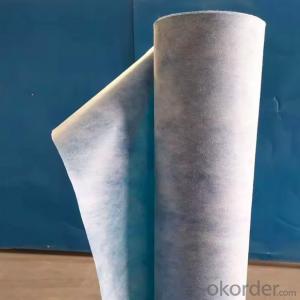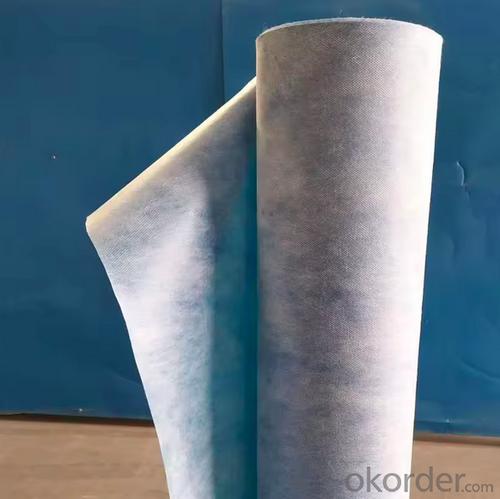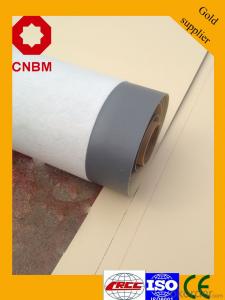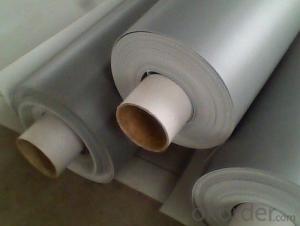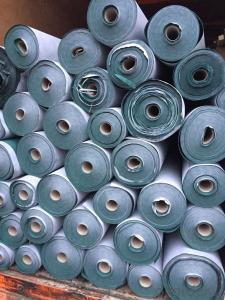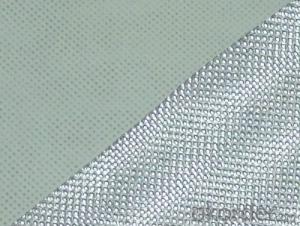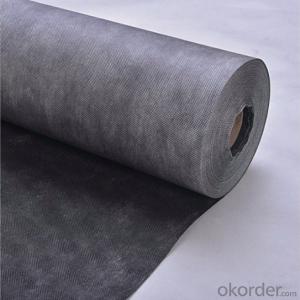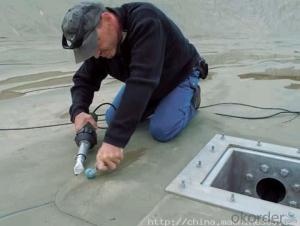Wholesale Breathable Membrane 1Mtr X 50Mtr Breathable Roofing Felt Roll 100 GSM
- Loading Port:
- SHANGHAI
- Payment Terms:
- TT OR LC
- Min Order Qty:
- 500 m²
- Supply Capability:
- 100000 m²/month
OKorder Service Pledge
OKorder Financial Service
You Might Also Like
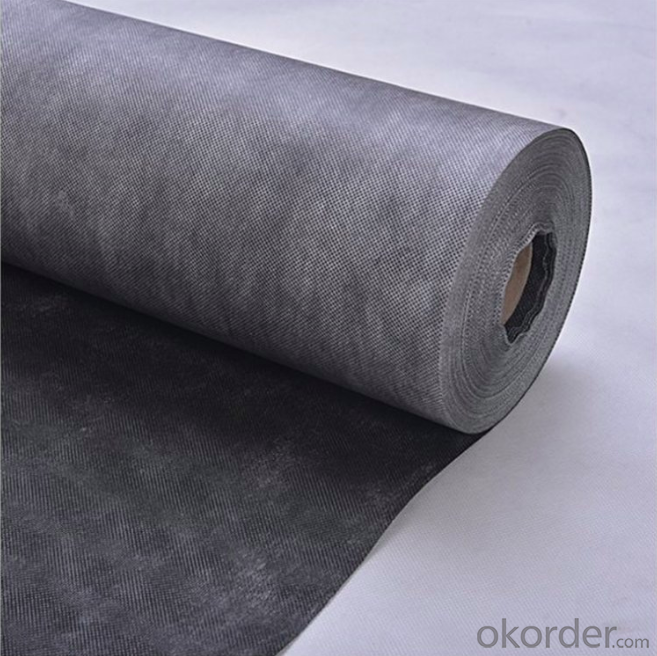
Product Feature:
Air open & vapour permeable
More breathable than any other 'air open' underlay on the market
Lowest vapour resistance of all breathable membranes
Being both air open & vapour permeable further minimises the risk of condensation forming
No ventilation required
Strong 3 layer material
Superior nail tear strength
| Mass per unit area: | 140g/m2 |
| Product Type: | Waterproofing Breathable Bembrane For House Wrapping |
| Material: | PP/PE granule |
| Tensile Strength(MD/XD): | 190N/5cm(+-20%)/150N/5cm(+-20%) |
| Resistance to tearing(MD/XD): | >50N/50N |
| Flexibility at low temperature: | (-)24°C |
| Resistance to water pentration: | W1 |
| Temperature resistance | (+)70°C |
| Resistance to UV | 3momths |
| Loading quantity | 40' HC ---2000rolls |
Our company :
our company is a leading professional manufacturer in China, which locates in Yangzhou State-grade Development Zone,Yangzhou City, Jiangsu Province, nearby Shanghai.
We have advanced production lines with the technology from Italy and Germany, which are applied to nonwoven products, film lamination, roofing materials, disposable medical products, packaging materials and so on.Main products:Nonwoven fabric , SMS, SMMS and manufactured productsFilm or foil laminated products Roofing membrane, flooring underlayPE woven fabric, PE tarpaulin, vapor barrierGreenhouseWe not only have first-class processing line, but have first-grade quality management. We have been qualified by ISO9001 (quality) and CE, this system can supply active way to guarantee the quality. We have exported to many countries, such as Canada, USA, Chile, Argentina, New Zealand, Australia, Malaysia, Japan, Ukraine, Latvia, Slovenia, Slovakia, Spain, CZ, Russia, Croatia, Bulgaria, Romania, Italy, UK, Germany, Greece and so on. With a group of excellent senior management and hi-tech R& D personnel and our skilled workers, we can supply you the goods with competitive prices and better quality. We look forward to establish friendly and long term relationship with you in the near future.
FAQ:
1. who are we?
We are based in Jiangsu, China, start from 2008,sell to Eastern Europe(18.00%),Southern Europe(15.00%),Northern Europe(15.00%),Western Europe(12.00%),South Asia(6.00%),Eastern Asia(5.00%),Oceania(5.00%),Central America(5.00%),Southeast Asia(5.00%),North America(3.00%),South America(3.00%),Africa(3.00%),Domestic Market(3.00%),Mid East(2.00%). There are total about 11-50 people in our office.
2. how can we guarantee quality?
Always a pre-production sample before mass production;
Always final Inspection before shipment;
3.what can you buy from us?
Breathable Membrane, Reflection Breathable Membrane, Housewrap, Vapor Barrier, Heat Insulation Film
4. why should you buy from us not from other suppliers?
We not only have first-class processing line, but have first-grade quality management. We have been qualified by ISO9001 (quality) and CE, this system can supply active way to guarantee the quality. We have exported to many countries, such as Canada, USA,
5. what services can we provide?
Accepted Delivery Terms: FOB,CFR,CIF,EXW;
Accepted Payment Currency:USD,EUR,JPY,CAD,HKD,CNY;
Accepted Payment Type: T/T,L/C,Credit Card,PayPal,Western Union,Cash;
- Q: Can a waterproofing membrane be applied on vertical surfaces?
- Yes, a waterproofing membrane can be applied on vertical surfaces. Waterproofing membranes are designed to create a protective barrier against water penetration, and they can be effectively applied on vertical surfaces such as walls or columns to prevent water damage or leakage.
- Q: Can a waterproofing membrane be used for tunnels and subway stations?
- Tunnels and subway stations can benefit greatly from the use of waterproofing membranes. These membranes are specifically designed to keep water and moisture out of structures, which makes them perfect for underground spaces like tunnels and subway stations that are prone to water infiltration. Made from high-quality materials like bitumen or synthetic polymers, these membranes have exceptional water-resistant properties. The advantages of using waterproofing membranes in tunnels and subway stations are numerous. First and foremost, they protect the structural integrity of the underground infrastructure by preventing water from seeping into the concrete or other building materials. This safeguards against corrosion and degradation, ensuring the longevity and safety of the structure. Additionally, waterproofing membranes contribute to a dry and comfortable environment within tunnels and subway stations. By preventing water accumulation, they eliminate the growth of mold, mildew, and other harmful microorganisms. They also help regulate humidity levels, which reduces the risk of condensation and water damage to equipment, electrical systems, and other components. Moreover, waterproofing membranes act as a barrier against external contaminants such as pollutants, chemicals, and gases. This is especially important in subway stations, where the concentration of pollutants from train exhaust and other sources can be higher. In conclusion, using waterproofing membranes in tunnels and subway stations is essential for ensuring the durability, safety, and comfort of these underground structures. They provide an effective solution for keeping water out, protecting the infrastructure, and maintaining a dry and healthy environment for passengers and staff.
- Q: Can a waterproofing membrane be used in conjunction with insulation materials?
- Using both insulation materials and a waterproofing membrane together is often recommended in order to protect buildings from moisture and improve energy efficiency. The waterproofing membrane acts as a barrier against water infiltration, while the insulation materials help regulate temperature and minimize heat loss or gain. By combining these components, the building envelope can effectively shield against water damage and maintain a comfortable indoor environment. Proper installation and compatibility between the waterproofing membrane and insulation materials are crucial for achieving optimal performance and long-lasting results.
- Q: Can a waterproofing membrane be applied on a sloped surface?
- Yes, a waterproofing membrane can be applied on a sloped surface. In fact, it is often necessary to apply a waterproofing membrane on sloped surfaces to ensure proper drainage and prevent water infiltration. The membrane is designed to adhere to various surfaces, including sloped ones, providing a protective barrier against water penetration.
- Q: Can a waterproofing membrane be used in residential or commercial structures?
- Yes, a waterproofing membrane can be used in both residential and commercial structures. Waterproofing membranes are designed to create a barrier that prevents the penetration of water into the structure. They are commonly used in areas such as basements, foundations, roofs, and bathrooms to protect the building from water damage. In residential structures, waterproofing membranes can help prevent water leaks, mold growth, and structural deterioration. In commercial structures, they are often used to protect valuable assets, such as equipment and inventory, and to maintain a safe and healthy environment for employees and customers. Additionally, waterproofing membranes can be applied to both new construction projects and existing structures, making them a versatile solution for any type of building.
- Q: Can a waterproofing membrane be used in conjunction with roofing materials?
- Yes, a waterproofing membrane can be used in conjunction with roofing materials. In fact, it is commonly used to provide an additional layer of protection against water infiltration and to enhance the overall waterproofing capabilities of the roof.
- Q: Can a waterproofing membrane be used on crawl spaces?
- Crawl spaces often encounter moisture and water problems, which can lead to mold growth, structural damage, and other issues. By utilizing a waterproofing membrane, water seepage into the crawl space can be prevented, ensuring its dryness and protection. This membrane, typically composed of a durable and flexible material, is installed on both the walls and floor of the crawl space, creating a moisture barrier. This approach proves particularly advantageous in regions with high groundwater levels, heavy rainfall, or homes situated in flood-prone areas. Moreover, the application of a waterproofing membrane aids in enhancing indoor air quality by inhibiting the growth of mold and mildew, which thrive in damp environments. In summary, the utilization of a waterproofing membrane in crawl spaces effectively prevents water damage and maintains a healthy living environment.
- Q: Can a waterproofing membrane be used for a water tank?
- Indeed, a water tank can utilize a waterproofing membrane. The purpose of a waterproofing membrane is to obstruct the flow of water, rendering it a perfect resolution for the sealing and safeguarding of water tanks. It effectively averts leaks and seepage, guaranteeing the preservation of water stored in the tank without any diminution or contamination. Moreover, a waterproofing membrane can augment the tank's resilience and lifespan by shielding it against external factors like corrosion, chemicals, and UV radiation. Selecting a top-notch waterproofing membrane that is explicitly formulated for water tanks is vital to ensure impeccable functionality and enduring safeguarding.
- Q: Can a waterproofing membrane be used in areas with high groundwater levels or flooding?
- Yes, a waterproofing membrane can be used in areas with high groundwater levels or flooding. Waterproofing membranes are designed to provide a barrier against water infiltration and can effectively protect structures from water damage. These membranes are typically made of materials such as bitumen, rubber, or synthetic polymers, which are impermeable to water. They are applied on various surfaces such as foundations, basements, roofs, and walls to prevent water penetration. In areas with high groundwater levels or frequent flooding, the use of a waterproofing membrane becomes even more crucial. The membrane acts as a protective layer, preventing water from seeping into the structure and causing potential damage. It ensures that the interior of the building remains dry and free from water-related issues such as mold, mildew, and structural deterioration. However, it's important to consider the specific conditions of the site and the level of groundwater or flooding. In some extreme cases, where water pressure is high or flooding is prolonged, additional waterproofing measures may be necessary, such as installing a drainage system or using thicker and more robust membranes. Consulting with a professional waterproofing contractor or engineer is recommended to ensure the appropriate membrane system is chosen and installed correctly for the specific conditions of the site.
- Q: Can a waterproofing membrane be used on aluminum surfaces?
- Yes, a waterproofing membrane can be used on aluminum surfaces.
Send your message to us
Wholesale Breathable Membrane 1Mtr X 50Mtr Breathable Roofing Felt Roll 100 GSM
- Loading Port:
- SHANGHAI
- Payment Terms:
- TT OR LC
- Min Order Qty:
- 500 m²
- Supply Capability:
- 100000 m²/month
OKorder Service Pledge
OKorder Financial Service
Similar products
Hot products
Hot Searches
Related keywords
